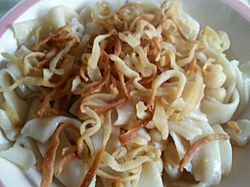Ciceri e tria facts for kids
 |
|
| Type | Pasta |
|---|---|
| Place of origin | Italy |
| Region or state | Salento |
| Main ingredients | chickpeas and fried pasta |
Ciceri e tria is a delicious pasta dish from Italian cuisine. It started in a part of Italy called Apulia, especially in the Salento region. This dish is made mainly with pasta and chickpeas, and it even includes some fried pasta! People often eat it as a primi piatti, which means it's served as a first course in a meal. It's known as a classic and special dish from the Salento area and all of Apulia.
Contents
What is Ciceri e Tria?
Ciceri e tria is a traditional Italian dish that brings together simple ingredients to create a tasty and satisfying meal. It's a popular choice in its home region, showing off the local cooking style.
Where Did It Come From?
This unique pasta dish first came from the Salento region of Italy. Salento is located within the larger region of Apulia, which is in the "heel" of Italy's "boot" shape. It's a very common and loved dish there.
What Do the Words Mean?
The name "Ciceri e tria" tells you a lot about the dish:
- Ciceri means "chickpeas" in Latin. Chickpeas are small, round beans often used in cooking.
- Tria means "pasta" or "noodle." This word comes from an old Arabic word for pasta. It's an old term that people still use in many parts of Southern Italy, especially in Sicily. Sometimes, "tria" can even refer to a type of pasta called tagliatelle.
How It's Made
Ciceri e tria uses pasta and chickpeas as its main ingredients. It's a simple dish, but it has a special twist!
Key Ingredients
The two most important parts of Ciceri e tria are:
- Pasta: Often a flat, wide type of pasta.
- Chickpeas: These are a type of legume, sometimes called garbanzo beans.
Some versions of the dish might have a lot of liquid, like a thick soup, so you might even eat it with a spoon!
The Special Fried Pasta
Here's what makes Ciceri e tria unique:
- Part of the pasta (about one-third to one-half) is fried in oil until it's crispy.
- The rest of the pasta is boiled, just like regular pasta.
- Why fry some of it? Long ago, when meat was hard to find, frying the pasta made the dish feel more "meaty" and filling. It also adds a nice crunch!
Cooking the Chickpeas
In Apulia, the chickpeas are often cooked slowly over low heat. If you're using dried chickpeas, you might need to soak them in water the day before you cook them. This makes them softer and easier to cook.
Other Flavors
Chefs might add other ingredients to make the dish even tastier, such as:
The dish is often seasoned with black pepper. Some people even say it tastes a bit like bacon! You can also serve it as a side dish with bread or rice.
Serving the Dish
In Apulia, Ciceri e tria is commonly served as a primi piatti.
What is a Primi Piatti?
In a traditional Italian meal, primo (or primi piatti for plural) is the first course. It usually consists of a hot dish like pasta, risotto, or soup. Ciceri e tria fits perfectly into this part of the meal.

